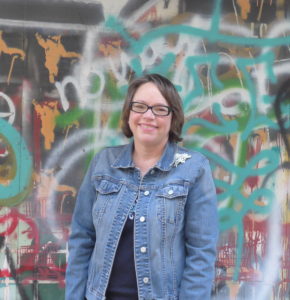Five Questions with Ann Hillesland
Sophie Rosenblum: We’re publishing your piece, “Gravity and Wind” in the next issue of NANO Fiction. There is a kind of love story happening within the clouds in this piece and, at the same time, it feels like it very well might be the ending of a relationship. How did you manage to pack all of that into fewer than 300 words?
Ann Hillesland: I got the idea to write a piece that took place while skydiving. I’ve never been skydiving myself, but I imagined that when up there a person would be at the mercy of two forces, gravity and wind, so I paired that with a character who is emotionally at the mercy of outside forces. I guess that is one way to pack in meaning—to marry the setting and the character so that they reverberate off each other to amplify the story’s themes.
SR: How long do you typically work on a piece of flash fiction, and when do you know your work is ready for public consumption?
AH: For me, the time varies quite a bit. Sometimes I write a piece, give it to my writer’s group, and revise and send it out the day after getting their comments. Other times pieces sit quite a bit before I revise them—a big time lag is more the norm. I can be a very slow reviser, mostly because I tend to give my writing a lot of space between first draft and revision. This piece is definitely on the long side. I originally wrote it in 2012, but as you can see, I waited several years before revising and sending it out. I need to get a piece clear in my mind–what I consciously intended, what I unconsciously wrote. I think that can be harder for flash fiction than for longer pieces, because my conscious mind is less in control. Sometimes it takes a while for me to figure out what was going on when I wrote a flash. And then one day I remember a story I wrote three or four years ago, open up the file, and I know what I need to do to make it ready for publication.
SR: Your bio tells me you’re a California native with an MFA from Queen’s University of Charlotte. How does living in different places change your writing?
AH: Queens is a low residency school, so I didn’t actually live in Charlotte, just went out for a couple of weeks a year. However, it did have a big effect on my writing. On my first taxi ride through Charlotte, I looked at all the brick buildings and thought, Won’t they fall down when there’s an earthquake? That’s when I realized I wasn’t in California anymore.
Many Southern writers went to Queens, and many of them felt strongly that they had a regional identity and a regional literature. I started to wonder if California had a regional literature, and what that might be, and how my writing might fit into it. I also thought about what I loved about California that I missed, even when gone for a week: the golden hills, the oak trees, the redwoods, the pacific ocean, the mix of immigrants from all over the world. I started to write more consciously about my native state.
SR: Describe your perfect day.
AH: Well, it starts with breakfast out. I love going out to breakfast. Then I drive my Miata to the ocean. I walk in the sand and wade in the water. The Pacific on the part of California I’m from is very cold—the current comes from Alaska. I wade until my feel start to feel numb. If I’m lucky, I see a line of brown pelicans skimming the water. Then I go someplace out of the wind for lunch. At the restaurant I get an idea for a flash fiction and jot it down. After lunch, I go to an antique shop and look for vintage hats and jewelry. I come home and have dinner with my husband and we spend the evening on the couch together, reading. The night will be warm enough for us to open the windows and hear the crickets.
SR: What can we expect next from Ann Hillesland?
AH: In addition to flash pieces and essays coming out in journals, I’m finishing up the first draft of a novel set in San Francisco. It’s about young tech workers looking for a missing friend, for a stolen painting, and for love. I’ve had quite a bit of fun with setting in this book—scenes take place at many famous and less famous locations in the city. Sometimes it seems like the city has been completely transformed by the tech boom. I’ve stood in line half an hour for a scoop of gourmet ice cream and asked myself what has happened to San Francisco. But then I go to the Palace of Fine Arts or Fort Point, and everything seems almost the same as it was when I was a kid on a grade school field trip.
